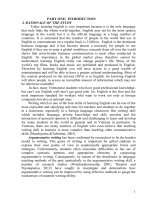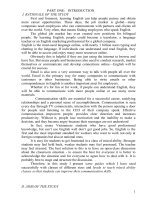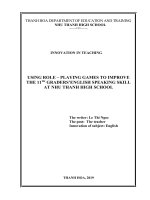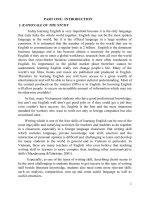USING GAMES TO HELP STUDENTS IMPROVE THEIR ENGLISH COMMUNICATION SKILLS AT NHU THANH HIGH SCHOOL
Bạn đang xem bản rút gọn của tài liệu. Xem và tải ngay bản đầy đủ của tài liệu tại đây (506.75 KB, 13 trang )
PART ONE: INTRODUCTION
I. RATIONALE OF THE STUDY
There are many reasons why learning a new language is a good idea. It
allows people to communicate with the others. It helps people to see things from
a different perspective, or get a deeper understanding of another culture. It helps
citizens to become a better listener. It even has health benefits, as studies have
shown that people who speak two or more languages have more active minds
later in life 400 million people around the world speak English as their first
language. Not only that, but English is listed as one of the official languages in
more than a quarter of the countries in the world. That’s a lot of new people you
can communicate with just by improving one language!
What’s more, English is the rest of the world’s “second language”. While
Chinese Mandarin and Spanish are the mother tongues of more people overall,
most people in the world choose to learn some English after their native
language. In fact, one in five people on the planet speak or understand at least a
little bit of English.
Communication skills are essential for a successful career, satisfying
relationships and a personal sense of accomplishment. Communication is seen
every day through TV commercials, interaction with the person opening a door
for people and listening to the CEO of their company speak. Effective
communication empowers people, provides clear direction and increases
productivity. Without it, people lose motivation and the inability to make a
decision, and they become angry because their messages are not understood
In fact, many Vietnamese students who have good professional
knowledge, but can’t use English well don’t get good jobs. So, English is the
first and the most important standard for workers who want to work not only at
foreign companies but also at national ones.
Since English is a foreign language in our country, most students
especially high school students are not familiar with it (Hetrakul, 1995). Kavin
Hetrakul also said that they use English more frequent only inside the class and
less frequent outside the class. Whereas, students have limited time to learn
English in class, and they still do not have enough encouragement to practice
English outside the class in order to get familiar with English. This case brings a
problem that make high school students have difficulties to communicate in
English.
At Nhu Thanh High school, my students often find it difficult to
communicate in English, especially in new curriculum.
Therefore, in this study I present some games which I have used
successfully with classes of different sizes and levels to improve the students’
speaking skills.
II. AIMS OF THE STUDY
I do the research to know about the fact of teaching and learning
communication skills in Nhu Thanh High School more clearly. This study also
investigates whether the games can have positive impact on process among
students and can develop their communication skills or not. Bearing in mind, I
1
decide the research with title “ some games to improve the students’ English
speaking skills at Nhu Thanh High School.
III. RESEARCH QUESTIONS
This study aims at finding answer to the following research question:
How can games help the students at Nhu Thanh High School improve
their speaking skill?
The question has been addressed to the class B2 that I have been teaching
in Nhu Thanh High School with the aim to examine how games affect the
process of speaking here.
IV. SCOPE OF THE STUDY
This study does not aim to teach any skill in a systematic way, because it
is experience not for teaching but for practice. The study investigates games to
help students practice so that they can improve their speaking skill.
V. METHODS OF THE STUDY
In this study, I use some research tools to collect and analyze the needed
data
Recording is used to record the process of giving some games
The second tool used in this study is interviews with students at the end of
the research to study whether games is really suitable for them or not.
Surveying through the answer sheets is used to know the practical
situation of teaching and learning English speaking skill.
2
PART TWO: DEVELOPMENT
CHAPTER 1: LITERATURE REVIEW
I.The difficulties of the students’ learning English speaking skill
Kavin Hetrakul also said that they use English more frequently only
inside the class and less frequently outside the class. Whereas, students have
limited time to learn English in class, and they still do not have enough
encouragement to practice English outside the class in order to get familiar with
English. This case brings a problem that makes high school students have
difficulties to communicate in English.
One of the causes that make the students difficult in speaking English is
that the environment does not support the students to speak English frequently.
The environment here means the people outside the class. Those people may
think that the students just want to show off when they speak English for daily
conversation. The response that the students get makes them loose their selfconfidence to improve their speaking. Since the students do not want to be
rejected by the people around them, so they use their native language in daily
conversation. That makes the students unable to communicate in English
fluently outside the class.
The second cause is problem with grammar. English always deals with
reference of time while Vietnamese does not have one. Moreover, there are
singular and plural forms that the students have to distinguish and still many
forms that have to be learned. Most students are very easy to get confused with
English grammar, while grammar is very needed to form a right sentence. If the
students do not have grammar mastery, of course they will not be able to
produce sentences that grammatically right. Realizing that the grammar students
have is very weak, so they feel embarrassed when they want to produce English
sentences orally.
II. Games and their impacts on developing students’ speaking skill
Games are used as methods or techniques to involve students in learning.
Well-chosen and designed games are invaluable as they give students a break
and at the same time allow learners to practice language skills. The benefits of
games range from cognitive aspect of language learning to more co-operative
group dynamics and as a result games are highly motivating since they are
amusing and at the same time challenging. Ersoz(2000) states that games can be
used to give practice in all language skills and they can be used to practice many
types of communication.
Huyen (2003) identifies the advantages of using games to learn English in
the classroom: a) Games add relaxation and fun, so the learners retain words
more easily. b) Games involve friendly competition, so it keeps learners
interested and motivated. c) Vocabulary games bring real world context to the
classroom. Mei (2000) emphasizes similar points by saying that it encourages
active learning, as well as collaboration and interactivity. Interactive learning
techniques also hold memory, performance and social benefits. According to IJung (2005) the benefits of using games in language-learning include that games
are learner centered, encourages creative and spontaneous use of language and
foster participatory attitudes of the learners. Kim (1995) states more general
3
advantages of using games in the classroom and they include: Games are a
welcome break from the usual routine of the language class. They are motivating
and challenging. Learning a language requires a great deal of effort. Games help
students to make and sustain the effort of learning. Games provide language
practice in the various skills- speaking, writing, listening and reading.
They encourage students to interact and communicate. They create a
meaningful context for language use. Students learn through experimenting,
discovering and interacting with their environment. Students need variation to
increase their motivation. By using games students already have a context in
which the use of the target language is immediately useful.
Lastly, but not least, games of any kind are usually fun. Students who are having
fun are always motivated, so they will find speaking made more interesting and
more enjoyable, and will begin to improve as a result.
CHAPTER 2: PRACTICAL SITUATIONS
I. METHODS OF THE STUDY
The research is done qualitatively in the context of English class B2. In
this survey, I use the survey questionnaire for students. This survey is designed
to collect information for the study on “An investigation into the Reality of
teaching and learning English speaking skill at Nhu Thanh High School.
II. THE REALITY OF TEACHING AND LEARNING ENGLISH
SPEAKING SKILLS AT NHU THANH HIGH SCHOOL
The whole procedure of teaching and learning is implemented similarly to
all students of the class after all of them give consent to be part of the research.
However, due to the limit of the study, I only focus to collect information from
the learning engagement of class B2 during this process as the data for analysis.
Below is the survey of the practical situation of learning English speaking skill
Survey no.1
Practical Situation of learning English speaking Skill at Nhu Thanh High
School.
Questions
for
students
1. How difficult is
the
English
Speaking skill ?
2. What is your
idea
about
improving English
speaking skill at
your school?
3. What do you
think of your skill
classes at Nhu
Thanh
High
School?
A
B
C
D
Too easy
6%
Not
difficult
9%
Difficult
32%
Really
difficult
53%
Very
essential
12%
Essential
16%
Not really
essential
47%
Not
essential at
all
25%
Really
interesting
3%
Interestin
g
7%
Boring
41%
Really
boring
49%
4
4. What do you
think
of
the
materials used for
teaching skills at
Nhu Thanh High
School?
5. Does
your
teacher give you
guides to improve
your
speking
skills?
Difficult
and boring
51%
Difficult
but
interesting
8%
C. Interesting
and
stimulating
9%
Always
2%
Sometime
s
4%
Rarely
22%
Easy and
boring
32%
Never
72%
From the survey number 1, we can see that:
For students:
There are so many different students in class and the quality of each
student is uneven.
Many students haven’t determined the importance of English in the
current period, so they aren’t aware of their own learning.
Some students have a limited vocabulary so they can’t know how to speak
a correct sentence
Classrooms are crowded, and the activities of speaking lesson often
practise in pairs or in groups so the classrooms are easily noise.
For teachers:
There are still some teachers who have difficulty in teaching speaking
skills and choosing suitable activities for each lesson.
Teachers don’t assign the tasks to students clearly.
Teachers don’t create the environment to encourage students to speak
English effectively.
CHAPTER 3:
RECOMMENDATIONS
TO IMPROVE THE STUDENTS’ ENGISH SPEAKING SKILLS
I. RECOMMENDATIONS
According to the data analysis from the survey, it can be personally
concluded that the most important feature that makes my students to engage
more in the lesson is the kind of assessment which forces them to learn although
the meaningfulness of tasks also more or less affect the level of engagement
the most meaningful tasks to my students are tasks that can help them to pass the
tests at the end of the semester not tasks that give them reasons to communicate
as I expected.
Therefore, I have given them some games to improve my students’ speaking
skill.
5
The ability to communicate effectively is important in relationships,
education and work. Here are some games to help students develop good
speaking skills.
II. PRACTICAL SOLUTIONS
Learning English should be fun. We learn faster and more effectively
when we are engaged in learning and using games is a great way to make
learning more interesting.
1. Who's Telling the Truth?
Have each student write three facts about themselves that nobody in the
class knows on a piece of paper. Make sure each student includes his/her name
on the top of the paper. Collect the sheets of paper and bring three students to
the front of the room. Read aloud one of the facts that is true for one of the
students in the front of the room. The class then proceeds to question the
students in an attempt to determine who is telling the truth, and who is
lying. Each student is allowed to ask one question to one of the three
students. After a round of questioning, the students predict who is telling the
truth.
2. Taboo Variations
2.1. Create a PowerPoint presentation with each slide containing a
noun. Have one student come to the front of the room and sit with his/her back
to the PowerPoint. The students in the class should take turns describing the
words for the student in the front of the room to guess.
2.2. Separate the students into groups of 4/5. Place a pile of cards with
random nouns in the center of the group. Have students take turns describing the
nouns for their group members to guess. The group member who guesses
correctly keeps the card in an attempt to have the most cards at the end of the
game.
2.3. (Advanced speakers). Separate the class into two teams. Students are
given a word to describe to their teammates, in addition to a list of words that
they cannot use in their description. Each student should have 2-3 minutes to see
how many words his/her teammates can guess.
3. Descriptive Drawing Activity
Pair up the students and give them each a picture face down. They must describe
the picture for their partner to draw.
4. Comic Strip Descriptions
Give each student a portion of a comic strip. Without showing their
pictures to one another, the students should attempt to describe their image, and
put the comic strip into the correct order. After about ten minutes, the students
can predict the order, show one another their portion, and see if they were
correct!
5. "Secret" Word
6
Students are given a random topic, and a random word completely
unrelated to the topic. The student must hide the word in their speech, without
the other students in the class guessing their "secret" word. The other students in
the class must listen carefully to the speech, in an attempt to discover the secret
word.
6. Debates
Give each student a piece of paper with “agree” written on one side, and
“disagree” on the other side. Read aloud a controversial statement, and have
each students hold up his/her paper stating whether they agree or
disagree. Choose one student from each side to explain his/her position and
participate in a short debate.
7. Impromptu Speaking
Split the class into two teams, and use a list of impromptu speaking
topics. Have each student choose a number, and respond to the statement
without preparation. The student must continue speaking for 45 seconds when
the teacher calls out "stop." As the student is speaking, the other team listens for
any hesitation, grammatical mistakes or vocabulary mistakes. If the other team
can correctly identify an error, they get a point.
8. Desert Island Activity
Give each student a piece of paper and tell him or her to draw an
item. Any item. Tell the students that they have been stranded on a desert island,
and only half of the class can survive and continue to inhabit the desert
island. The student's goal is to convince the class that they should survive. The
hard part is that the only thing they have is an item that was drawn a few
minutes earlier by a classmate on the piece of paper.
9. Storytelling Activity
Bring four students to the front of the classroom. Three students should sit
down in a row, and one of the students should stand behind them acting as a
controller. The controller should have a stack of cards in his hand containing
nouns. The controller will hand a noun to one of the three students who will start
to tell a story. The student will continue telling the story until the controller
decides to hand another noun to another student who will then take over the
story.
10. Two Truths, One Lie
Each student should write three facts about themselves on a piece of
paper. Two of the facts should be the truth, and one should be a lie. Students
read aloud the facts, and give the other students a chance to question them and
decide which statement is a lie.
11. True/False Storytelling
Give each student a piece of paper with either the word “true” or
“false.” Each student should tell the class a story, and the class must guess
7
whether the story is the truth, or a lie. To add to the activity, you can allow the
other students to question the student telling the story.
12. I Have Never…
All students in the class should start holding five fingers in the air (this
number can be adjusted depending on how many students are in the class). The
student who begins the activity will tell the class one thing that he/she has
NEVER done. The students who have done that activity should put a finger
down, and tell the class a story about this activity.
7. Circle action game
On the board, write:
“I’m (name). I like
.”
“You’re (name). You like
.”
Students work in groups of 8-12. Give the animal to one person. He
introduces himself and says something he likes. (“I’m Hoa. I like skiing.”) As he
says what he likes, he makes a gesture demonstrating it. For example, he moves
his body as if he was skiing or uses two fingers flying down a mountain to
represent a skier. Then he throws the object to the next speaker. (If there is no
object, he just points to the next speaker).
The next speaker must repeat the first speaker’s information and do the
gesture before adding her own information and gesture. (“You’re Hoa. You like
skiing. I’m Lan. I like listening to hip-hop.”) She adds a gesture such as a hiphop dance movement or something to show listening to music. She throws the
object to the next person who has to remember and repeat both Hoa’s
information and Lan’s.
The game continues. Everyone has to remember each person’s
information and do each gesture: #2 remembers #1. #3 remembers #1 and #2. #4
knows #1, #2 and #3. #4 knows 1-2-3-4, etc. If someone forgets (no problem. It
will happen.), the person gives a hint by showing the gesture. That is often
enough to help the speaker remember the name as well as the thing he likes. If
not, the person can give the information, either by speaking aloud or by
mouthing the information silently (like lip-reading).
III. SOME PRACTICAL EXAMPLES AFTER GIVING GIUDES IN THE
EXPERIMENTAL CURRICULUM AT NHU THANH HIGH SCHOOL.
Example 1:
ENGLISH 11
Unit 1- FRIENDSHIP- B-SPEAKING
Using “Two Truths, One Lie”
Each student should write three facts about their friend on a piece of paper:
- He is friendly and humorous
- He is interested in Mathematics
- He often go swimming in his free time.
8
Two of the facts should be the truth, and one should be a lie. Students read
aloud the facts, and give the other students a chance to question them and decide
which statement is a lie.
Example 2:
ENGLISH 11
Unit 6- COMPETITIOS- SPEAKING
Using “Debates”
Give each student a piece of paper with “agree” written on one side, and
“disagree” on the other side. Read aloud a controversial statement
- English competition gives students opportunities to practice speaking
English.
and have each student hold up his/her paper stating whether they agree or
disagree. Choose one student from each side to explain his/her position and
participate in a short debate.
9
10
CHAPTER 4: RESULT
In conclusion, giving games is an efficient way to teach English. This way
I get the best results in the classroom. It arises students’ motivation.
11
They felt more confident when they were participating in oral face-to-face
discussions.
Students were able to discuss numerous topics and express their opinions
which all students in the interview admitted was more comfortable to do in an
online environment, especially in a culture where people do not often openly
state their opinions.
Students became more motivated in class and were actually talking more
with their classmates. It was also noticed that students began to express more
opinions and give extended reasoning in not only their face-to-face interactions
but also in their written classwork.
Moreover, The result of testing skills has increasingly improved. The
following is the result chart of class B2.
Before giving guides
Class
B2
Excellent Good Fair
(%)
(%) (%)
2,1
11,9
Poor
(%)
35,2 50,8
After giving guides
(Speaking tests)
Excellent Good Fair
Poor
(%)
(%)
(%)
(%)
10,3
28,7
34,8
26,2
14,3
34,2
35,7
15,8
PART THREE: CONCLUSION AND SUGGESTION
I. CONCLUSION
To sum up, the research has brought to me some important lessons of
English communication teaching and learning in general and of working with
my students in particular.
As a result of students forming their own discussions, this enabled the learning
to become student-centered rather than teacher-centered.
II. SUGGESTION
It does not matter indoor or outdoor, we can not deny the importance of
games. If students learn with games, have fun, feel happy and free, it means that
you have reached your goals. Games strengthen language skills,besides,
learners develop social skills and good relationships while they interact with
each others.
Whatever your goal is (speaking, writing, listening, reading,grammar
points,vocabulary) you must believe that every game you have students play, is
much more useful than tons of exercises and worksheets and you get more
positive results than anything else.
The Headmaster’s identification
Thanh Hoa, the second of May, 2018
I ensure that this study has been written by
me.
The writer
12
Nguyen Huu Hoang
REFERENCES
Ersoz, A. (2000) Six Games for the EFL/ESL Classroom in The Internet
TESL Journal, Vol. VI, No.6.
Hong, L. (2002) Using Games in Teaching English to Young Learners in
The Internet TESL Journal, Vol VIII, No.8.
Gaudart, H. (1999) Games as Teaching Tools for Teaching English to
Speakers of Other Languages in Simulation Gaming, 30:283
Huyen, N.T.T. & Nga, K.T.T. (2003) Learning Vocabulary through games
in Asian EFL Journal.
I-Jung. C, (2005) Using Games to Promote Communicative Skills in
Language Learning in The Internet Kim, L.S. (1995) Creative Games for the
Language Class in English teaching Forum 33:1.
Kopecky, A. (2009) Using Games to Motivate your Adult ESL Students.
Kumar, R. & Lightner, R. (2007) Games as an Interactive Classroom Technique
in International Journal of Teaching and Learning in Higher Education. Volume
19, Number 1, 53-63.
Mei, Y.Y. (2000) Using Games in an EFL Class for Children in Daejin
University ELT Research Paper.
13









